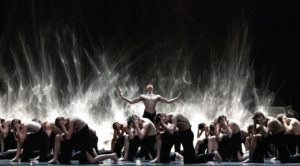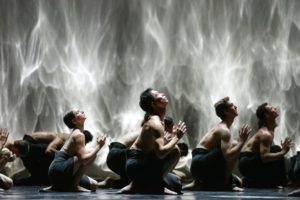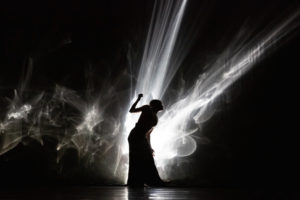National Ballet of Canada: Crystal Pite’s Angels’ Atlas / Mixed Bill - Vancouver Ballet Society
- Home
- Reviews 2020 - 2023
- National Ballet of Canada: Crystal Pite’s Angels’ Atlas / Mixed Bill

It was a long wait but worth it. Almost 11 years after Crystal Pite astonished the National Ballet of Canada’s hometown Toronto audience with her first large-ensemble work, Emergence, the now internationally renowned choreographer returned to the Four Seasons Centre with a new ballet for the company, which premiered February 29. It proved an even greater triumph.
Superficially, Angels’ Atlas — the enigmatic title was a late arrival in the creative process — bears some resemblance to Emergence. It is about the same half-hour length and of much the same scale, deploying a cast of 36, just two fewer than Emergence. Only two from that 2009 cast, Tiffany Mosher and Nan Wang, reappear in Angels’ Atlas. The remainder — almost half of them corps members and some very young — came to the project as novices in Pite’s signature style of weighted, close-to-the-floor movement. Happily, they acquitted themselves with distinction.

Pite’s sensible attitude when working with big ballet companies appears to be that if you have the numbers you may as well use them. She’s by no means alone in this. Large ensembles look impressive even if the choreography is shallow; Pite’s is anything but. Her ensembles are more than assemblages of individuals. They cohere as organic entities and acquire metaphorical importance.
There was a lot of repeated, unison movement in Emergence and the same is true of Angels’ Atlas, except the social coalescence evoked in the former is absent. The ensemble in Angels’ Atlas often seems fraught and only precariously united, as if threatened by some unseen force. While it can move with precision, rapidly shifting direction like a squad of squid, the ensemble also fragments unpredictably into eddies of chaos before regathering its composure. The ensemble often recedes to make way for duets and solos that serve to remind us that Angels’ Atlas is as much about individuals as humanity as a whole.
Nancy Bryant costumes men and women alike in black split-pants with attached skirt-like panels. The men are bare-chested. The women wear faux-nude tops. This enhances the sense of undifferentiated humanity without resorting to androgyny. Sometimes the ensemble divides along gender lines and the duets mostly pair men with women. The choreography for the women, however, is forceful and avoids female gender stereotyping.
Jay Gower Taylor’s hive-like set for Emergence complemented Pite’s choreography in a fairly conventional, almost decorative way. In contrast, his design for Angels’ Atlas is indispensable to the work’s success. Indeed, as Pite explained in a useful program note, it was the impetus for the ballet.

Taylor, Pite’s life partner and most frequent design collaborator, had been exploring ways of manipulating reflected light. Working with Irish lighting designer Tom Visser, another frequent Pite collaborator, Taylor came up with floating, shifting, painterly images that create an illusion of three-dimensionality and unfathomable depth. They have a numinous beauty and suggestion of cosmic mystery that is central to the ballet’s atmosphere and, to the extent that it is open-ended, the work’s overall meaning.
In Angels’ Atlas, Pite tackles the big existential issues, primarily the situation of humanity within a random, unknowable universe. Because the questions this raises are unanswerable, Angels’ Atlas does not attempt to do so. Rather, it invites contemplation and, in the very act of dancing, suggests a means of existing in the midst of chaos.
The ballet’s three parts are linked by the loosest of quasi-narrative threads, an apparent relationship between a symbolic lead couple (Hannah Galway and Siphesihle November on opening night). Each part is musically defined. A spiritual mood is immediately established by Tchaikovsky’s “Cherubic Hymn” from the Liturgy of St. John Chrysostom. It returns in the final section with Morten Lauridsen’s O Magnum Mysterium. In between, Owen Belton provides a pulsing electronic score-cum-soundscape of otherworldly moodiness.
The parts are united by a generalized sense of yearning and grief. Images of mortality recur, but so too do assertions of strength and resilience. This is not a dystopian ballet; ultimately, it offers a glimpse of the sublime. To call it a ballet seems somehow inadequate. It is an event, an experience, even a spiritual ceremony.
Pite’s new ballet was part of a mixed program that included a revival of Wayne McGregor’s dazzling Chroma and the company premiere of an oddity from 1963, Frederick Ashton’s painfully dated, dramatically compressed dance rendering of Alexandre Dumas’ novel La Dame aux Camélias. Titled after that melodrama’s principal characters, Ashton’s Marguerite and Armand was made as a showcase for Royal Ballet superstars Margot Fonteyn and Rudolf Nureyev. Nobody else danced it in their lifetimes and Ashton died in 1988 hoping nobody ever would. Yet, for some reason, subsequent star ballerinas, starting early this century with Sylvie Guillem, have found the role of an ill-served, up-market whore who, shamed and abandoned, dies of “consumption” (a mid-19th-century euphemism for syphilis) irresistible.
The latest is Greta Hodgkinson, who chose Ashton’s cliché-ridden work as her exit vehicle after an impressive 30-year career — 24 of them as a principal dancer — with the National Ballet. Although Hodgkinson danced with characteristic grace, dramatic intelligence and luxuriant musicality, the final pathetic image of Marguerite’s lifeless form was perhaps not the most felicitous with which to bid her fans farewell.
— MICHAEL CRABB

